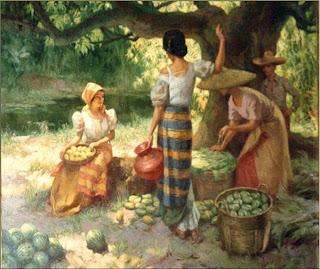 Image via WikipediaFernando C. Amorsolo(1892-1972) is the first National Artist for Visual Arts (Painting) in 1972. He is considered as one of the most important artist for painting in the Philippines. His work has influenced many Filipino artists in landscape painting and for backlighting technique in which is popular. It is believed that his worked for paintings and sketches have reached more than 10,000 units. Many of these items are already distributed all over the world through auctions and collections. One of his items is already auctioned off at about US$ 440,000 in May 2010.
Image via WikipediaFernando C. Amorsolo(1892-1972) is the first National Artist for Visual Arts (Painting) in 1972. He is considered as one of the most important artist for painting in the Philippines. His work has influenced many Filipino artists in landscape painting and for backlighting technique in which is popular. It is believed that his worked for paintings and sketches have reached more than 10,000 units. Many of these items are already distributed all over the world through auctions and collections. One of his items is already auctioned off at about US$ 440,000 in May 2010.He started his career at 13 years old serving as apprentice to his mother cousin, Don Fabian dela Rosa which is also a painter. His first triumph is winning the 2nd prize for his painting Levendo Periodico organized by the Asociacion Internacional de Artistas in 1908.
At age 17 he enrolled at Art School of Liceo de Manila where he earned honors and for his paintings and drawings. Amorsolo study also in UP school of Fine Arts and graduated in 1914 with medals. Before graduation he worked in Pacific Commercial Company and after graduation he work as Draftsman at Bureau of Public Works, as Part-Time Instructor in UP. His famed outside the country was first recognized after he joined the Ezposicion de Panama in 1914 having his entries of portrait of President Woodrow Wilson and an intriguing piece entitled La Muerte de Socrates.
After 3 years of work as an Instructor and commercial artist, he caught the attention of Don Enrique Zobel de Ayala and given him scholarship in Academis de San Fernando, Madrid in which he study bright colors of impressionists Sorolla, Zorn, Monet and Renoir. After a year he returned home and began teaching in University of the Philippines in which he work for total of 38 years and later he was appointed as Director for School of Fine Arts.
Among his work famous work was “My Wife, Salud”, “El Violinista”, “Rice Planting”, “Noonday Meal of the Workers”, “The Conversion of Filipinos” before Japanese regime. During Japanese occupation, his work includes “The Rape of Manila”, “The bombing of Intendencia”, “The Explosion”, and “The Burning of Manila” shows the tragedy and pain of Filipino people.
Some of his awards are 1st Prize - New York's World Fair for “Afternoon Meal of Rice Workers” in 1929, Gold Medal - UNESCO National Commission in 1959, Republic Cultural Heritage Awards in 1967 and in 1972 he was named as the first Filipino to be distinguished as the Philippine's National Artist in Painting.
 |
| Baguio-1932, 19 x 26 inches |
 |
| Bathers 1932 |
 |
| Cockfight |
 |
| Collection, The Lopez Museum |
 |
| Defence of a Filipina Woman's Honor 1945 |
 |
| lithograph, Asleep 1919 |
 |
| lithograph, Fragrant Rose 1919 |
 |
| lithograph, Magdalene 1919 |
 |
| lithograph, Maple Leaves 1919 |
 |
| lithograph, The Butterfly 1919 |
 |
| lithograph, The Love Story 1919 |
 |
| lithograph, Two Roses 1919 |
 |
| lithograph, The Bluebird 1919 |
 |
| Man and Chicken - 1929, 24 x 30 |
 |
| Princess Urduja |
 |
| Princess Urduja -1946 |
 |
| 23 1/2 x 33 inches, Manila 1925 |
 |
| 24 x 32 inches, 1931 |
 |
| 1933, 12 x 17 inches |
 |
| 1956, approximately 23 x 33 inches |















































No comments:
Post a Comment